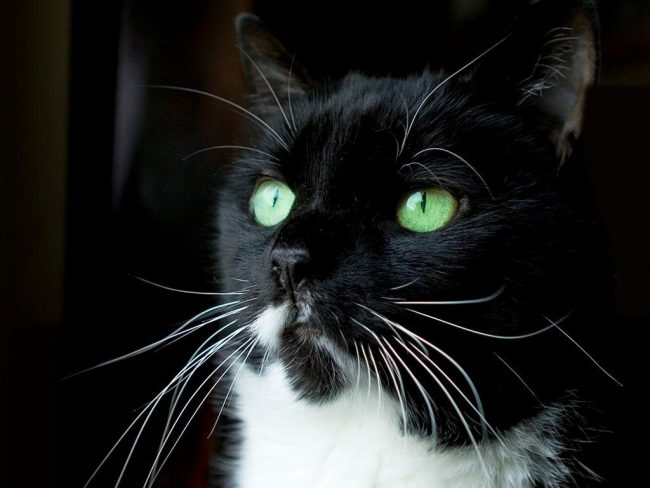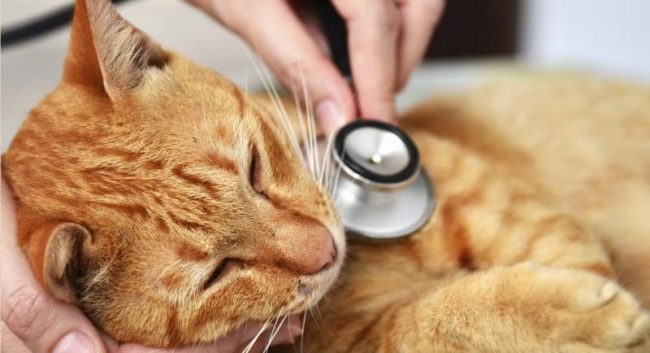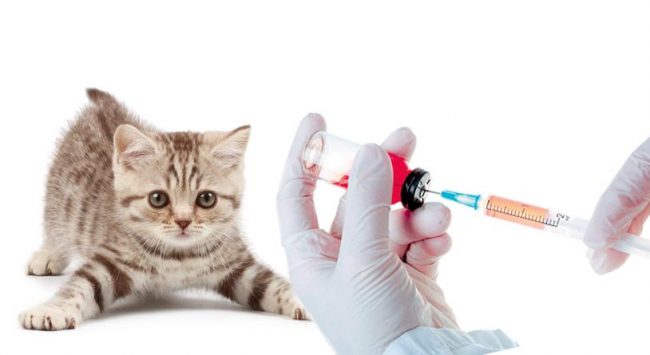
Each owner of fluffy pets should be able to recognize symptoms of rabies in cats. Rabies is a deadly viral infection affecting the nervous system.
For most people, the word “rabid” is associated with uncontrollable and aggressive animals attacking people.
In a sense, the rabies that cats experience is really changes the behavior of the pet and makes it look like wild.
In fact, rabies is a disease caused by a dangerous a virus that seriously affects the nervous system.
His main danger is that rabies applies not only to animals, but also to people, in addition, it is lethal.

Rabies is a deadly viral infection.
Each year, more from this viral disease. fifty thousand people and several million animals.
Such disappointing statistics are explained by almost one hundred percent fatal rabies infection.
It affects even big cats like Maine kuna usher, norwegian forest cats, Kuril Bobtail pixy bob ragdoll and turkish vana.
Despite the fact that wild animals are mostly sick with rabies, pets can also get infected, and lately this trend has become more frequent.
Cats get sick more often than dogs. That is why every owner cats need to know the symptoms of rabies in order to identify the ailment.
Content
- 1 How is rabies virus transmitted?
- 2 Key signs of rabies in cats
- 3 Precautions when interacting with an infected person cat
- 4 Is there a cure for feline rabies?
- 5 Rabies Prevention
How is rabies virus transmitted?
Contents
Domestic cat rabies virus is transmitted along with saliva animal when it produces a bite.
Also, transmission occurs through damage to the mucosa shell or skin.
So, the transmission of the virus goes through the following stages:
- The infection spreads quickly from the bite area to the nerve fibers and penetrates the spinal cord.
- Then it enters the brain, where it accumulates and multiplies, producing irreversible destruction.
- After infection of the brain, rabies spreads in all organs and tissues of the body, reaching the salivary glands. So Thus, bacteria enter the animal’s saliva.

Rabies infects the central nervous system of an animal
The causative agent of rabies is a spherical virus of size 100-150 nanometers.
When infected, in the cytoplasm of central nerve cells nervous system of the infected organism Babesa Negri.
The main signs of rabies in cats
Many breeders are interested in the question – how is it manifested rabies?
A feature of the rabies virus is that it does not appear. immediately after infection of the animal with a virus carrier.
The first symptoms become noticeable after the disease spread throughout the body of the pet.
If an adult cat was infected, then the period of spread diseases, the so-called incubation, or latent period lasts from ten days to six weeks.
In case of infection of the kitten, the latency period much faster – less than seven days.
Sometimes there are exceptions in which incubation of rabies virus in an adult cat, it occurred within one year.
If you are interested in knowing how old your cat is human standards, we recommend that you familiarize yourself with articlehttps: //kot-pes.com/skolko-let-koshke-po-chelovecheskim-merkam/

In kittens, the incubation period is faster than after a week
At the same time, the danger is that the virus enters the saliva on early stages, before it reveals itself in behavior animal, namely for seven to ten days.
Common symptoms of rabies in cats include:
- Behavioral changes in which the pet becomes either aggressive, or vice versa, lethargic. With aggression, extreme anxiety, and with lethargy – a retarded reaction;
- Rapid cat meow. In this case, the animal is atypically loud screaming;
- Loss of appetite;
- Periodic cramps and paralysis;
- Sudden death of a pet.
For a person, the most serious problem is that everything these symptoms appear on average one week after the cat becomes a contagious virus carrier.
Infection can occur not only after a cat bite.
An apparently healthy animal can infect a host through saliva, that is, a danger to humans is present even when contact with a calm pet.

An infected animal can be very calm in appearance
There are three forms of feline rabies, among which are:
Violent form
The violent form of rabies, according to statistics, is the most often.
The flow of a violent form takes place from three to eleven days and is divided into stages such as:
- Prodromal stage
This is an early stage during which the cat becomes very lethargic, weakly reacts to commands and behaves alienated, reluctantly obeys the owner.
After some time, the state of the cat changes to shy and restless, the animal becomes extremely nervous.
The pet is constantly listening, looking around and inadequately reacts – can scratch or bite for no reason.
If your pet is healthy but still bites and scratches, learn how to wean him from aggressive behavior, you can from articleshttps: //kot-pes.com/kak-otuchit-kota-kusatsya/
In addition, the cat loses interest in toys and other inedible subjects.
She is constantly worried about the place of the bite, which became the place of transmission infections in the body.
The stage ends with an upset gastrointestinal tract, which are manifested in vomiting and diarrhea within two to three days.
- Manic stage
This stage lasts from three to five days.
It is characterized by the appearance of pharyngeal spasms in a cat muscles – one of the main symptoms of the disease.
Because of spasms, the animal risks choking every time, with difficulty swallows water.
He also has a very high salivation rate, the result of which is stuck together on the face and neck wool.
The manic stage is accompanied by increased excitement. a pet that becomes overly aggressive and furious.
The cat throws himself at the owners and other animals, and usually aims in the neck and face.

At the manic stage, the animal increases salivation
After some time, the animal ceases to run amok and vice versa, becomes oppressed and exhausted.
During this period, it searches for dark corners, motionlessly lies there.
But one has only to take effect on such external stimuli as bright light or loud sound as the pet becomes extremely extreme again violent and aggressive.
- Depressive stage
For two to three days, the cat’s depressive stage paralysis appears and progresses, voice disappears, sagging lower jaw and tongue falls out.
Excessive salivation occurs from the mouth, eyes become cloudy and start to mow.
Paralysis begins with the hind legs, then goes to the trunk and forelimbs.
Finally, when paralysis reaches the heart and respiratory organs, the cat dies.
Paralytic form
This form of rabies is relatively mild, and lasts for two to four days.
In this case, the cat becomes intrusive, overly affectionate and constantly goes after the owner, asks for his hands.
Due to constant contact, danger to humans to be infected rabies through saliva is particularly high.

Rabies leads to feline paralysis
Atypical form
This form of the disease is quite rare.
During its course, the animal has gastritis and enteritis, which are accompanied by vomiting, diarrhea with blood and general exhaustion of the body.
At the same time, signs of atypical rabies may alternate with temporary improvement of the cat’s body condition.
Therefore, it is sometimes difficult to recognize a disease in this form.
In any case, the outcome for the animal will be fatal.
Precautions when interacting with an infected person cat
In cases where the pet is often on the street, and on its body scratches or bites appear, the responsible owner must take the cat to the veterinary clinic immediately without waiting manifestations of the symptoms of the disease.
Even if the animal has been vaccinated against rabies, it can be held revaccination.
After that, the cat will need to be left under surveillance for 1-2 months.

With scratches and bites on the cat’s body, it should immediately be shown to the veterinarian
If an animal develops symptoms of some form of rabies, the owner should take the following measures:
- Isolate the cat and do not approach it. Best kept an animal in a separate room, for example, in a locked room;
- Contact a veterinary clinic and tell the doctor about pet symptoms. After that, specialists from special equipment and take away the animal;
- If the saliva of the animal has come on the skin, or it bit, scratched the owner, it is necessary to wash the wounds and abrasions running water using laundry soap.
Also, owners should be wary of their children, who contacted with street kittens.
The risk of getting street cats rabies is very high, because they are not vaccinated and can be bitten by a rabid rat or dog.
Is there a cure for feline rabies?
If the veterinarian determines that the symptoms of the imported animal are not a consequence of rabies; pets are treated.
If the diagnosis is confirmed and the cat is really infected – they put him to sleep.

Unfortunately, rabies is not treated – sick animals put to sleep
All people who contacted the cat are prescribed anti-rabies treatment.
Since with a possible treatment of a pet, the probability is very high infection of medical personnel of a veterinary clinic, treatment animals with this diagnosis are not performed.
Rabies prophylaxis
To preventive measures to prevent the occurrence of rabies in a cat, include:
- Vaccination. This method is the most effective, but it can be carry out only after changing the kitten’s teeth, if it is contained in apartment. If the animal is regularly on the street, then the vaccine do at the age of three months. In addition, the effect from vaccination persists for 12 months, respectively, cat need to be vaccinated annually;
- Extermination of rodents in premises and on personal sites (deratization). This method is also effective because reduces the likelihood of animal contact with potential virus carriers.

Regular vaccination is the best way to prevent rabies
Although vaccination is relatively hassle-free a preventive way to protect a cat from rabies, it is worth it only with an eye to the following rules:
- Before the vaccine, the cat needs to completely remove the worms, if they are, that is, to deworm;
About how to treat a cat for worms, you can read here: https: //kot-pes.com/glisti-u-koshek/
- A kitten cannot be vaccinated before his teeth change;
- If the cat is sick or is weakened by any trauma, pregnant or immediately after childbirth, it also cannot be vaccinated.
Symptoms of Rabies in Cats: Key Findings ailment
Each owner of fluffy pets should be able to recognize symptoms of rabies in cats. Rabies is a deadly viral infection affecting the nervous system. It does not spread only on animals, but also on people, moreover, in the early stages the disease is not diagnosed.






